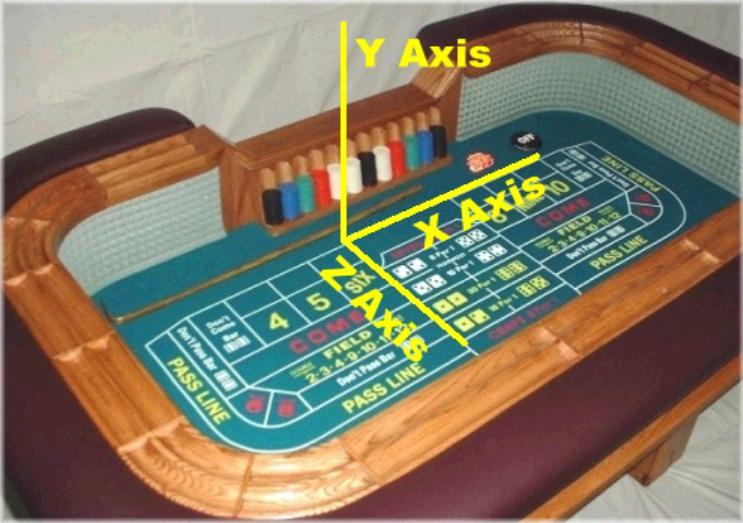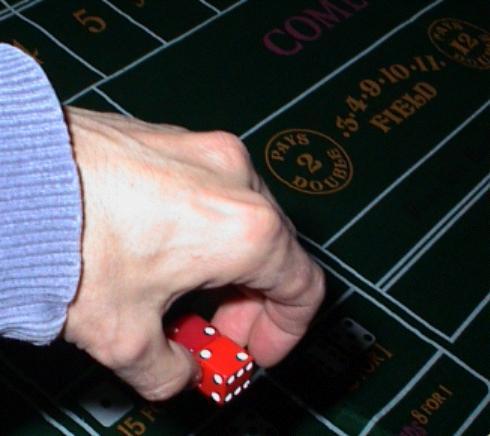 
| ||
|
|
|
Blackjack Insider Newsletter, March 2005, #62
Craps for Profit: The Math of Dice Control
By Dan Pronovost

Dan Pronovost is the owner and president of
DeepNet Technologies, makers of a wide range of gambling training products and software. Their web sites are: www.HandheldBlackjack.com and www.SmartCraps.com and all products are available for free trial download. Dan is the creator of the new card counting system Speed Count, which is being taught by Henry Tamburin and Frank Scoblete in the Golden Touch Blackjack two day courses: www.GoldenTouchBlackjack.com.Can anyone make money playing Craps?!
Some readers of Blackjack Insider may know me for my company's blackjack training products (
www.HandheldBlackjack.com), and other works in the statistical study of blackjack. Well, we embarked last year into a new area of gambling, and after spending over a year researching, developing and writing, we have just launched a new software product: Smart Craps (for Windows). Smart Craps is based on brand new mathematical methodologies, designed to answer with statistical and scientific clarity, the infamous question plaguing advantage craps players everywhere:"Can anyone honestly get an edge over the casino playing craps?"
Before I answer this question (in this, and a continuing series of upcoming articles), let me start by saying that this is a very controversial subject, and will raise the shackles of many 'experts' (maybe even you, fine reader!). But before you judge too quickly, please be fair, and read the analysis presented here, and to be continued in future newsletters. Smart Craps, and the ideas it uses, are new. Nobody has looked at dice control from the perspective we use, and with the rigorous statistical approach we've applied.
So… to answer this question (and lay down them fightin' words): yes, craps is a beatable game, provably with statistical certainty, in the hands of the skilled dice controller. Flipping the coin for a moment, there will no doubt be some readers who play advantage craps already whose response would be, "Duh… I've known that! Been winning for years!" But winning, and proving you are winning with statistical relevance, are two different things. And, as this series of articles will reveal, Smart Craps will show that most dice controllers are not playing optimally, or even worse, think they are playing with an advantage and are not doing so. Smart Craps is much more than just a proof: it is a software tool to help dice controllers maximize their edge, tune their game, and learn what edge is possible.
Jumping ahead…
These ongoing articles will be 'stand alone', meaning that you do not need to use or have the Smart Craps software to understand or follow along. But for the curious, or those who want to jump ahead, you can download the software from:
www.SmartCraps.com/SmartCrapsInst.exe
Just download this exe, save it on your Windows computer, and run it. The software is shareware, which means you can try it out for free. The documentation is over 100 pages, including everything you need to know and covers basically everything we'll talk about in these articles.
The Theory of Dice Control
This is intended as a brief summary only on dice control and the physical skill of dice setting. If you want to master the physical skill of dice setting, you will want to read and consult with some of the resources at the end of this article. Unlike card counting in blackjack, dice setting is a physical skill, and cannot be mastered through reading and mental practice alone.
Dice setters attempt to control the physical throw of the dice in such a way as to influence the outcome of the dice. This skill, when used consciously at different points in the game, generates a non-random distribution of outcomes, which the shooter hopes reverses the casino's edge in the game to the player's favor. To understand the physics of dice control, let's look at an actual craps table:

Figure 1: Axes of rotation on a craps table
With these labels, we can see that a shooter will be throwing the dice along the X axis toward the end of the table. Generally, a skilled dice setter will hold the dice together, parallel to the Z axis, as shown below:

Figure 2
: Throwing the dice parallel to the Z axis of the tableA typical controlled shooter is attempting to cause the dice to rotate only along the Z axis. In theory, any spin in the Y or X axis can introduce unexpected bounces and a less controlled outcome. With a spin in only the Z axis, the outside numbers on the dice set should not occur in the final roll result.
Now that we understand the basic physics of dice control, we can see that the actual dice set is relevant for a skilled shooter. The set determines exactly what numbers are on top and on the sides for both dice. In the above figure, the twos are on top and the fours are on the front. The standard notation used in Smart Craps would describe this dice set as T2F4/T2F4, meaning the two on top and four in front for the left die and right die. The notation T3F5/T3F1 is often called the 3V set in popular texts, for example. Describing the top and front of a die (actually, any two adjacent sides will do) completely determines the values of the remaining sides. The 'T' and 'F' can be dropped, shortening the notation for a set, such as the 3V, to 35/31.
As well as limiting the spin of the dice to the Z axis, extremely proficient controlled shooters also try and fix the rate of spin for both dice to be the same. This can further reduce the dice outcomes for advantage play. For example, with a 22/44 or hard way set (sixes and ones on the outside), a perfectly controlled throw with Z axis rotation only at the same speed for both dice means the outcome should be one of: 22, 33, 44 or 55.
Using a hard way set again, suppose a controlled shooter achieves Z axis control but not rotation rate. In theory, the possible outcomes are the sixteen permutations of the four on-axis sides: 22, 23, 24, 25, 32, 33, 34, 35, 42, 43, 44, 45, 52, 53, 54, and 55. Notice that there are passing outcomes that sum to seven, as well as failures (61, 16). This will come into play when we talk about the statistics of dice setting, and the best way to determine if a skilled shooter is influencing the outcomes.
In the next sections, we discuss two ways of determining if a shooter is in fact influencing the dice outcomes: SRR (Seven to Rolls Ratio) and the new Pro Test© by DeepNet Technologies.
SRR - Seven to Rolls Ratio
Ok… you claim to be an expert dice controller, and making millions at craps. Good for you! Now, how do we prove it, with the same kind of mathematical certainty that we talk about with card counting in blackjack?
The most common statistical analysis of the game of craps to date is the SRR: seven to rolls ratio. This measures the number of seven sums in two dice compared to the other outcomes. If you are a random shooter, you will roll one seven in every six rolls (or, one seven for every five non-sevens). This simple fact can be seen if we look at all possible outcomes for the sum of two dice:
|
Roll: |
2 |
3 |
4 |
5 |
6 |
7 |
8 |
9 |
10 |
11 |
12 |
|
|
|
11 |
12 |
13 |
14 |
15 |
16 |
62 |
63 |
64 |
56 |
66 |
|
|
|
|
21 |
31 |
41 |
51 |
61 |
26 |
36 |
46 |
65 |
|
|
|
|
|
|
22 |
23 |
24 |
25 |
35 |
45 |
55 |
|
|
|
|
|
|
|
|
32 |
42 |
52 |
53 |
54 |
|
|
|
|
|
|
|
|
|
|
33 |
34 |
44 |
|
|
|
|
|
|
|
|
|
|
|
|
43 |
|
|
|
|
|
|
|
Total: |
1 |
2 |
3 |
4 |
5 |
6 |
5 |
4 |
3 |
2 |
1 |
= 36 |
Figure 3: Dice outcomes for a random shooter
The above table for a dice controller will be quite different, but the number we concentrate on is the number of seven outcomes. On the come out roll, we want to maximize the number of sevens (i.e. have the highest possible SRR fraction, or lowest SRR proportion value), and on any point roll we want to minimize the number of sevens (i.e. have the lowest possible SRR fraction, or highest SRR proportion value).
In Smart Craps, we model an SRR shooter by specifying both the minimum and maximum SRR ratio they are capable of achieving. Then, we can devise a betting system that uses the appropriate SRR for different situations (the minimum SRR on come out rolls and the maximum SRR on point rolls).
With the above approach, we can convert various SRR ratios to actual player edges. In Smart Craps, we do this by defining a simulation matching the SRR parameters, and running it for a few million rounds. For example, if we assume the following:
- Shooter uses a controlled throw on the come out roll that minimizes their SRR to 1:5.5.
- Shooter uses a controlled throw on all point rolls that maximizes their SRR to 1:6.5.
- Zero odds game, with flat pass line bets only.
- Player edge : +3.43% (using 100 million craps rounds, where each round is a single bet. 342 million rolls in this case).
While it is possible to determine the player edge mathematically with different SRR values in the case of simple flat pass line bets, things get more complicated when you add unusual bets and rules (vigs, odds, uneven payouts, etc.) Smart Craps makes it possible to determine the true edge empirically with real-world craps scenarios and conditions, using game simulation.
It is interesting to observe that the actual dice set is not relevant when simulating SRR shooters. The SRR is a direct result of their technique and set, not the other way around. But SRR shooters are no different from any dice setter: the principles of axis rotation discussed previously apply.
Also, the actual dice sums, while very relevant to computing player edge, are not directly correlated to the influence the dice setter achieves. For example, if a shooter uses a hardway set, they may still achieve perfect z-axis rotation, not getting an outside six or one to appear, yet a seven is rolled. For example, the outcome 34 and 25 indicate perfect z-axis rotation with a hardway set. Yet, they may fail to get z-axis rotation and still get a seven with a 61 or 16 outcome. This weakens the statistical accuracy of the SRR as a good measure of dice setting skill. SRR is great for computing player edge, but is a weak statistical measure of dice setting skill.
Enter Pro Test©… a fresh look at the statistics of dice setting, and a better mathematical approach to measuring skill and player edge.
Pro Test©: a better dice control metric
We've seen in the previous section that the seven to rolls ratio, while somewhat intuitive and useful for calculating player edge, is not the best possible measure of dice setting skill. This results from the fact that sevens can be both 'good' and 'bad', meaning that they occur when we both achieve and fail z-axis control. This weakens the statistical utility of SRR for determining player dice setting skill.
Let's take a fresh statistical look at dice control, starting with the basic physics principles described in the earlier.
Z-axis rotation
First and foremost, dice setters are trying to limit the dice rotation to the z-axis. This simply means that neither of the outside numbers shows up in the outcome. Hence, there are 4 times 4 = 16 possible outcomes that succeed in rotating in the Z-axis only. With a hardway set, this means each die outcome is one of: 2, 3, 4 and 5.
Secondly, a good dice setter tries to control the number of face rotations or pitches between the two dice when they do achieve z-axis control. Ideally, the two dice leave their hands in perfect symmetry, and rotate equally in the z-axis, bounce off the floor and back, and land with one of four possible outcomes. With a hardway set, this means one of: 22, 33, 44, or 55.
Thirdly, dice setters attempt to try to limit the number of double pitches when they achieve z-axis control. Ideally, the dice land up together (zero face rotations as noted above), or single pitch (are offset by 90 degrees or one rotation). Eliminating double pitches is useful with some dice sets, such as the hardway set: the only seven sums on the z-axis controlled outcomes occur when the dice double pitch (52, 25, 34 and 43). This can be relevant in different points of the game, such as point cycle rolls.
Thinking in practical terms, how do we know if a throw has stayed on z-axis rotation for any given dice set? Or, how do we know how many face rotations or pitches occurred on those successes? While it is very clear with a hardway dice set, other sets will lead to ambiguous results unless the dice are clearly marked (or colored) and the starting dice set recorded. For the purposes of the Pro Test, we always use a hardway set, to eliminate this challenge. Hence, the actual dice sums are completely irrelevant, and say nothing immediately about our edge in craps. But we will come back to this point, and show later how we can determine our edge once we have proven our dice setting skill.
A random shooter should achieve 16 z-axis controlled outcomes on average for every 36 rolls. Of these passes, four are zero pitches, and four are double pitches. For the curious, observe that three pitches is actually a single pitch in the other direction. With this knowledge we can now ask the million dollar statistical question:
"If I roll the dice a bunch of times and observe a certain number of z-axis controlled shots, what is the probability of this occurring randomly?"
This fancy looking question is really the mathematical equivalent of asking "Is there ample evidence that I am a controlled shooter?"
In our next episode… introducing Pro Test©!
Now that we have a better understanding of the physics of dice control, and the meaning of the current SRR analysis method, we can strive to come up with a better and more accurate statistical model for dice control.
In next month's article, we'll introduce the Pro Test©, the new mathematical model used in Smart Craps to analyze dice control. Pro Test is exactly what the title suggests: a test dice controllers can apply to roll sets to see if they are influencing the dice. Pro Test, since it models the maximum information content of dice control through three different and unique statistical tests, requires far less rolls to develop statistical certainty compared to the SRR method. In experiments with actual dice controllers, 50 to 500 rolls are often more than enough to provide statistical certainty (we'll talk about that term and its meaning more next month). But Pro Test is also more than just a tool to prove whether we're a skilled dice controller: it can be used with Smart Craps to optimize our dice sets, and compute our edge with any bet!
Once again, for those who are curious, you can download the software and read the documentation. Pro Test©, as well as everything we'll cover in this series of articles, is completely and thoroughly presented there. See our web site:
www.SmartCraps.com.Learning about dice control…
Ok… maybe we've raised your curiosity about dice control. Time to buy the book, and make millions, right? Wrong: dice control is a physical skill, very different from the discipline of card counting in blackjack. I tell people that it's a raw physical talent on order of complexity to juggling four balls without errors for many minutes at a time (and not two in each hand, for those who've tried!).
Dice control takes practice. And then, a whole bunch more practice. And then, you have to learn how to transfer that skill into the much more difficult realm of the casino floor. And then you're going to have good days and bad days, when you're "hot" or "cold" (not luck… but days when your dice influence skill is good or bad). If you want to get serious about dice control, be prepared to make a different and much larger time commitment compared to blackjack.
There are a few "hands-on" courses for dice control, the first of which I'd recommend is "Golden Touch Craps" by Frank Scoblete and partners (
www.GoldenTouchCraps.com). There are also some good (and bad) books, ranging from general interest to precise details. My favorites are "Get the Edge at Craps" by 'Sharpshooter' (deep with good math coverage), and "The Craps Undergound" by Frank Scoblete (a great dialogue from an experienced dice control and seasoned veteran). There are other great texts, and no insult is meant by their exclusion! Search amazon.com or check your favorite gambling store.
|
|
©2015, DeepNet Technologies. No material to be copied without express permission of DeepNet Technologies.
This site developed by
DeepNet Technologies, Ontario, Canada. Contact webmaster @ bjinsider . com
if you have problems.
This site is best viewed in a 800x600 graphics mode, or higher.
